ANTONITO, COLORADO: October 4, 2017
There couldn’t be a better day to explore the fall colors along the Cumbres & Toltec Scenic Railroad. The weather here has been windy, cold and rainy but today looks perfect. The mountain air is crystal clear.
A real but inactive steam engine, #483, identifies the station from the highway. Another steam engine, #489, simmers impatiently and the tender is piled high with huge black chunks of coal. This is the first of three steamed-up engines we will see; there are others in various places that won’t be used today. This railroad has a wealth of working locomotives. An undated roster reports that the Cumbres & Toltec Scenic Railroad has five operating coal-fired, steam-operated, narrow gauge K-class locomotives – #484, 487, 488, 489, and 463. Locomotive #489 joined the line in 2008 after an extensive recondition. Locomotive #483 is on display at the Chama station but is not in operation. Locomotive #463 returned to operation in 2013.
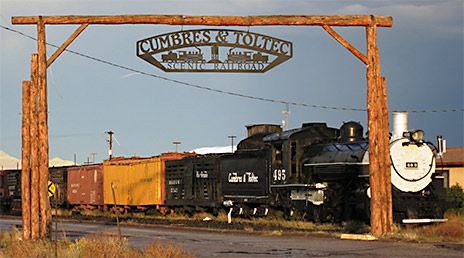
Entrance to Antonito Rail Yard with freight train on display.
Ted Blishak, Oct 5, 2017
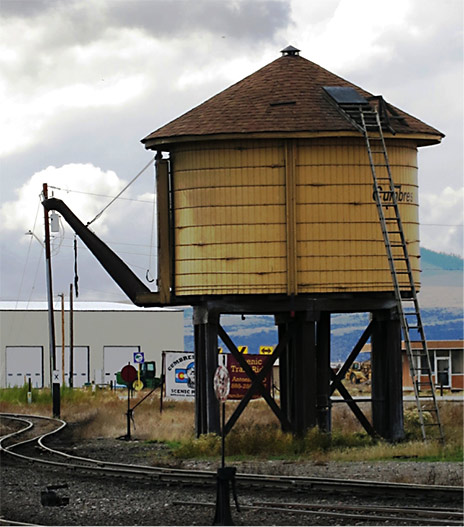
Steam locomotives use lots of water. This is a storage tank in Antonito.
Ted Blishak, October 5, 2017
Sylvia, walking with a cane on this trip, has been testing the railroads for their facilities for the mobility-challenged travelers. We called the Cumbres & Toltec the day before our arrival and arranged for wheelchair assistance both to and from the train as well as a lift up and into the train. The lift is built into the Service Car, where snacks and beverages are sold. Sylvia then walked back through the open air Gondola Car, the Tourist Car, and finally into our Parlor Car which brings up the rear. On the other side of the Service Car are Coach Cars for the budget-minded.
We held reservations for the sold-out rear parlor car, painted, like all the rolling stock, a cheerful red. Inside are comfortably padded chairs; each faces a tall window that slides down to open. Gifts are awaiting each of us – deluxe tote bags emblazoned with train décor, and glass mugs with the railroad’s logo.
Engine #489 chuffs our antique train into treeless desert as the car attendant regales us with a dreadful tale about Antonito’s early days. “Before there was a gallows for hanging miscreants, the law had to use imagination,” she says. ”An Antonito hanging committee (vigilantes?) brought a horse thief out to the nearest railroad bridge - the one we are coming up to - but it wasn’t high enough. They tried again, climbing to the roof of a railway car. Finally they decided they must attach the rope to the smokestack.” Although hangings are no longer scheduled, this is definitely the Wild West, with wilderness as far as one can see.
The flat land is now changing, climbing in elevation and the tracks eventually reach the tree line. Lone engine #489 easily carries the train over hills.The engineer, who seems to be an experienced musician, entertains passengers with the steam whistle.
Most of us keep our windows open and enjoy the smell of the copious black coal smoke occasionally wafting in.
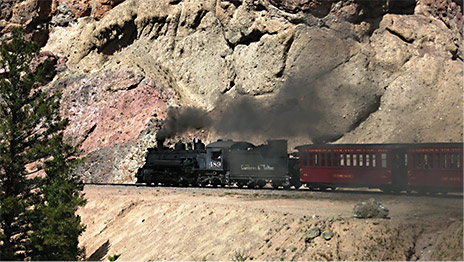
Engine #489 pulls the train over the hills
Entering these foothills of the Rocky Mountains, called the San Juans, the tracks weave back and forth over the Colorado/New Mexico state line twelve times between Antonito and Chama. Originally this narrow-gauge route was used to haul silver ore from the mountain mines to Denver. A similar story lies behind most of Colorado’s various tourist railroads that began as freight trains but now bring visitors to marvel at the unique mountain scenery.
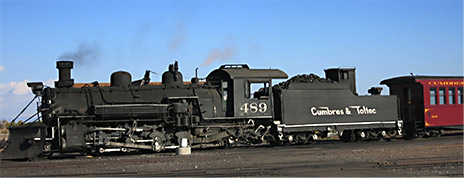
Coal-fired Cumbres and Toltec RR Engine #489
There is a bar in our car that is always open serving complimentary soft drinks, coffee, and hot chocolate. Plates of ripe fresh fruit are delivered to each seat.
Out the window, there are dark-green forested mountains, with explosive patches of bright-yellow aspens. Just a few are still green.
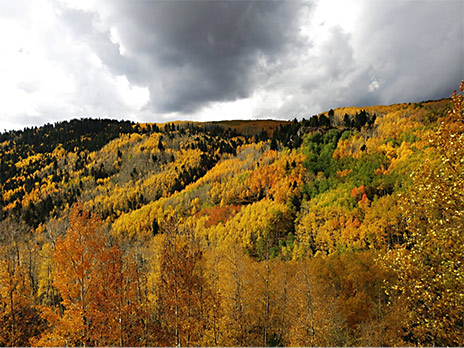
San Juan Foothills of the Rocky Mountains
The explanation? Aspens surround a “mother tree” to which they connect by roots. When mother turns yellow, they all do. A few are turning orange, while others have stayed green, again with orders from mom.
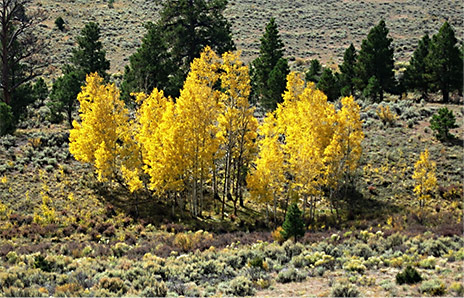
"Mom" turns yellow first
Our perfect weather has turned to a dark sky with rain, and then very noisy hail. , ambiance, and take time to look at the provided brochure. When the sun comes out again, which it does most of the time, we can see piles of hail that remain in tree shadows.
Osier is the lunch stop. The train that began at Chama, traveling the rails in the opposite direction, sighs on the parallel track.
The food, freshly prepared right here, is a wonderful surprise - far better than one might expect at this remote location. The cooks live up here and arise at 4 am to start roasting the turkeys. Lunch includes stuffing, mashed potatoes, gravy, two vegetables, cranberry sauce, and desert. Salad is optional. A delicious meatloaf lunch is another available option. A glowering grey sky, flashes of distant lightning, and the rumble of thunder reminds us that on an earlier trip, before this building was constructed in 1986, lunch was served to us under the open sky.
After our one-hour stop at Osier, whistles reminded us to reboard for the climb up to Cumbres Pass—at 10,022 ft, the highest point on the line. During a stop here of several minutes, the train crew goes to every car to set the air brake retainers for the continuous 4% downgrade from here to Chama. From now on there is little stack talk, but the groaning and squealing of the brake shoes fills the air during this daring descent.
At Chama, the end of the line, it’s raining again as we board a deluxe motor coach back to Antonito Station. The driver, who has been doing this job for years, tells us about the thinly settled area.
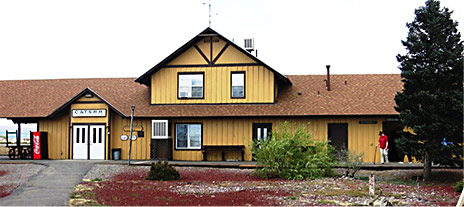
Antonito Station. Ted Blishak, October 5, 2017
“This big white bus scares them away, but in the morning when I drive my pickup truck to work, I’ve seen bears, wolves, and mountain lions. The train used to run all year, but the snow was hard to control in spite of a number of snow fences, which are still in evidence. The railroad finally left winter out of the schedule. October 22 is the last run this year, service will resume May 25, 2018.”
The driver points out that Antonito, like many small towns across America, is suffering financial woes and has lost its bank, its restaurants, and both of its gas stations. The nearest station is 14 miles north in the hamlet of La Jara.You can drive south from Antonito, over 60 miles, without finding a gas station, or indeed, anything else. In Antonito there is a hotel and a motel, both seemingly down on their luck and subject to dubious on-line reviews, which is why we stayed at a Holiday Inn Express in Alamosa, 28 miles away.
This journey is indeed a lucky chance for those who were born too late to experience the magic of steam railroading. And we who lived during the age of steam enjoy revisiting those days as well.
If you’d like to learn more about this trip, start by calling 1-888-286-2737, emailing info@cumbrestoltec.com, or visiting http://cumbrestoltec.com/. There are interesting websites for both the railroad itself, and the Friends of the Cumbres and Toltec Scenic Railroad. Prior reservations are strongly advised.
*Quoted from the Friends of the Cumbres and Toltec’s web page.
Please visit http//www.traintrips/biz for information about additional trips.
Trains & Travel International PO Box 313 Portola, CA 96122 1 800 359 4870 1 530 836 1944 http://www.traintrips.biz/ Chris@traintrips.biz
|